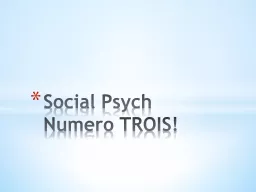

Numero TROIS The Need for Cognitive Dissonance Read pages 318320 This should hopefully clarify the idea of cognitive dissonance What to Know Cognitive Dissonance PostDecision Dissonance Justification of Effort ID: 592829
Download Presentation The PPT/PDF document "Social Psych" is the property of its rightful owner. Permission is granted to download and print the materials on this web site for personal, non-commercial use only, and to display it on your personal computer provided you do not modify the materials and that you retain all copyright notices contained in the materials. By downloading content from our website, you accept the terms of this agreement.
Slide1
Social Psych
Numero
TROIS!Slide2
The Need for Cognitive Dissonance
Read pages 318-320
This should hopefully clarify the idea of cognitive dissonance.Slide3
What to Know
Cognitive Dissonance
Post-Decision Dissonance
Justification of Effort
What are three ways we are likely to reduce dissonance?Slide4
Festinger
Study on Cognitive Dissonance
Festinger's
(1957) cognitive dissonance theory suggests that we have an
inner drive
to hold all our attitudes and beliefs in harmony and avoid disharmony (or dissonance)
.
Cognitive dissonance refers to a situation involving conflicting attitudes, beliefs or behaviors. This produces a feeling of discomfort leading to an
alteration in one of the attitudes
, beliefs or behaviors to reduce the discomfort and restore balance etc
.
Back to our famous
example, when people smoke (behavior) and they know that smoking causes cancer (cognition).Slide5
Attitudes may change because of factors within the person. An important factor here is the principle of cognitive consistency, the focus of
Festinger's
(1957) theory of cognitive dissonance. This theory starts from the idea that we seek consistency in our beliefs and attitudes in any situation where two cognitions are inconsistent
.
When someone is forced to do (publicly) something they (privately) really don't want to do, dissonance is created between their cognition (I didn't want to do this) and their behavior (I did it).
Forced
compliance occurs when an individual performs an action that is inconsistent with his or her beliefs.
The
behavior can't be changed, since it is already in the past, so dissonance will need to be reduced by re-evaluating their attitude to what they have done.
THIS HAS BEEN PROVEN IN AN EXPERIMENT – THE ONE WE WATCHED YESTERDAY!Slide6
AIM
Festinger
and
Carlsmith
(1959) investigated if making people perform a dull task would create cognitive dissonance through forced compliance behavior.Slide7
METHOD
In their laboratory experiment, they used 71 male students as participants to perform a series of dull tasks (such as turning pegs in a peg board for an hour).
They were then paid either $1 or $20 to tell a waiting participant (a confederate) that the tasks were really interesting. Almost all of the participants agreed to walk into the waiting room and persuade the confederate that the boring experiment would be fun. Slide8
RESULTS
When the participants were asked to evaluate the experiment, the participants who were paid only $1 rated the tedious task as more fun and enjoyable than the participants who were paid $20 to lie.Slide9
CONCLUSION
Being paid only $1 is not sufficient incentive for lying and so those who were paid $1 experienced dissonance. They could only overcome that dissonance by coming to believe that the tasks really were interesting and enjoyable. Being paid $20 provides a reason for turning pegs and there is therefore no dissonance.Slide10
CRITICAL EVALUATION
It tends to be a feeling or perception – so it is hard to measure.
There
are also individual differences in whether or not people act as this theory predicts.
Highly
anxious people are more likely to do so. Many people seem able to cope with considerable dissonance and not experience the tensions the theory predicts.Slide11
Ways to Reduce Dissonance
Slide12
Justification of Effort
Hazing…
“Justification of Effort” pg. 319Slide13
Justification of Effort
This theory is clearly implicated in the effect of rites of passage and hazing rituals on group solidarity and loyalty. The hazing rituals, prevalent in military units, sports teams and Academic fraternities and sororities, often include demanding and/or humiliating tasks which lead (according to dissonance theory) the new member to increase the subjective value of the group. This contributes to his/her loyalty and to the solidarity of the entire group.Slide14
Obscene and sexually explicit words
Aronson and Mills (1959)
Famous Experiment on Justification of Effort
Mild and
Tame words
Boring on matingSlide15
Aronson and Mills Study
One of the first and most classic examples of effort justification is Aronson and
Mills's
study.[2]
A
group of young women who volunteered to join a discussion group on the topic of the psychology of sex were asked to do a small reading test to make sure they were not too embarrassed to talk about sexual-related topics with others.
The
mild-embarrassment condition subjects were asked to read aloud a list of sex-related words such as prostitute or virgin. The severe-embarrassment condition subjects were asked to read aloud a list of highly sexual words (e.g. f*
ck
, c*
ck
) and to read two vivid descriptions of sexual activity taken from contemporary novels.
All
subjects then listened to a recording of a discussion about sexual behavior in animals which was dull and unappealing. When asked to rate the group and its members, control and mild-embarrassment groups did not differ, but the severe-embarrassment group's ratings were significantly higher
.
This group, whose initiation process was more difficult (embarrassment
equalling
effort), had to increase their subjective value of the discussion group to resolve the dissonance.Slide16
Other Ideas
People do not value what they do not pay for.